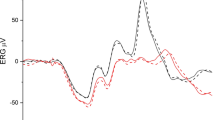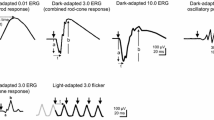Abstract
We investigated the possibility of performing electroretinography (ERG) in non-pharmacologically dilated eyes using brighter flash (time-integrated) luminance. Photopic (N = 26; background 25.5 cd·m−2, white LED flashes) and scotopic ERG (N = 23, green LED flashes) luminance response functions were obtained simultaneously in a dilated (DE) and non-dilated eye (NDE). In the NDE, photopic V max b-wave amplitude was reduced by 14% (P < 0.0001), implicit time prolonged (P < 0.0001), and retinal sensitivity (log K) decreased by 0.38 log units (P < 0.0001) with no effect on a-wave. Using a xenon strobe light (N = 6) to increase flash luminance, V max remained lower by about 12% in the NDE (P = 0.02). V max with LED and xenon was achieved at 3.9 ± 1.0 cd·s·m−2 and 3.3 ± 0.81 cd·s·m−2 in the DE and 10.6 ± 1.2 cd·s·m−2 and 12.3 ± 1.90 cd·s·m−2 in the NDE, that is an increase of 0.43 and 0.57 log unit (P < 0.0001), respectively. Increasing background luminance by 0.50 log units (80 cd·m−2, N = 4) resulted in implicit time normalization but not V max amplitude. Rod V max was decreased by 7% in NDE (P < 0.05) and sensitivity reduced by 0.40 log units (P < 0.0001), but our data suggest that the luminance may have not been sufficient to reach V max in all participants in the NDE and that the sensitivity change may have been due to an inadequate inter-stimulus interval. For the photopic ERG, increasing flash luminance is not sufficient to compensate for the smaller pupil size, whereas for the scotopic ERG, more data are needed to establish proper inter-stimulus interval to perform recordings in a non-pharmacologically dilated.






Similar content being viewed by others
Abbreviations
- DE:
-
Dilated eye
- ERG:
-
Electroretinogram
- NDE:
-
Non-dilated eye
- SF:
-
Standard flash
- LRF:
-
Luminance response function
References
Marmor MF, Holder GE, Seeliger MW, Yamamoto S (2004) Standard for clinical electroretinography (2004). Doc Ophthalmol 108:107–114
Marmor MF, Fulton AB, Holder GE, Miyake Y, Brigell M, Bach M (2009) ISCEV Standard for full-field clinical electroretinography (2008). Doc Ophthalmol 118:69–77
Decraene T, Goossens A (2001) Contact allergy to atropine and other mydriatic agents in eye drops. Contact Dermatitis 45:309–310
Iijima A, Haida M, Ishikawa N, Ueno A, Minamitani H, Shinohara Y (2003) Re-evaluation of tropicamide in the pupillary response test for Alzheimer’s disease. Neurobiol Aging 24:789–796
Kergoat H, Kergoat MJ, Justino L (2001) Age-related changes in the flash electroretinogram and oscillatory potentials in individuals age 75 and older. J Am Geriatr Soc 49:1212–1217
Chew HF, Markowitz SN, Flanagan J, Buys YM (2007) The effect of pupil dilation on driving vision in Canada. Can J Ophthalmol 42:585–591
Lachapelle P (1990) A possible contribution of the optic nerve to the photopic oscillatory. Clin vision sci 5:421–426
Hebert M, Lachapelle P, Dumont M (1995) Reproducibility of electro retino grams recorded with DTL electrodes. Doc Ophthalmol 91:333–342
Lachapelle P (1987) Analysis of the photopic electroretinogram recorded before and after dark adaptation. Can J Ophthalmol 22:354–361
Peachey N, Alexander K, Fishman G, Derlacki D (1989) Properties of the human cone system electroretinogram during light adaptation. Appl Opt 28:1145–1150
Wali N, Leguire LE (1992) The photopic hill: a new phenomenon of the light adapted electroretinogram. Doc Ophthalmol 80:335–345
Rufiange M, Rousseau S, Dembinska O, Lachapelle P (2002) Cone-dominated ERG luminance-response function: the Photopic Hill revisited. Doc Ophthalmol 104:231–248
Rufiange M, Dassa J, Dembinska O, Koenekoop RK, Little JM, Polomeno RC, Dumont M, Chemtob S, Lachapelle P (2003) The photopic ERG luminance-response function (photopic hill): method of analysis and clinical application. Vision Res 43:1405–1412
Fulton AB, Hansen RM (1987) The relationship of retinal sensitivity and rhodopsin in human infants. Vision Res 27:697–704
Dowling JE (1987) The retina. An approachable part of the brain. Harvard University Press, Cambridge
Joly S, Dorfman AL, Chemtob S, Moukhles H, Lachapelle P (2006) Structural and functional consequences of bright light exposure on the retina of neonatal rats. Doc Ophthalmol 113:93–103
Gonzalez P, Parks S, Dolan F, Keating D (2004) The effects of pupil size on the multifocal electroretinogram. Doc Ophthalmol 109:67–72
Westheimer G (2008) Directional sensitivity of the retina: 75 years of stiles-Crawford effect. Proc Biol Sci 275:2777–2786
Massof RW, Wu L, Finkelstein D, Perry C, Starr SJ, Johnson MA (1984) Properties of electroretinographic intensity-response functions in retinitis pigmentosa. Doc Ophthalmol 57:279–296
Author information
Authors and Affiliations
Corresponding author
Rights and permissions
About this article
Cite this article
Gagné, AM., Lavoie, J., Lavoie, MP. et al. Assessing the impact of non-dilating the eye on full-field electroretinogram and standard flash response. Doc Ophthalmol 121, 167–175 (2010). https://doi.org/10.1007/s10633-010-9242-1
Received:
Accepted:
Published:
Issue Date:
DOI: https://doi.org/10.1007/s10633-010-9242-1




